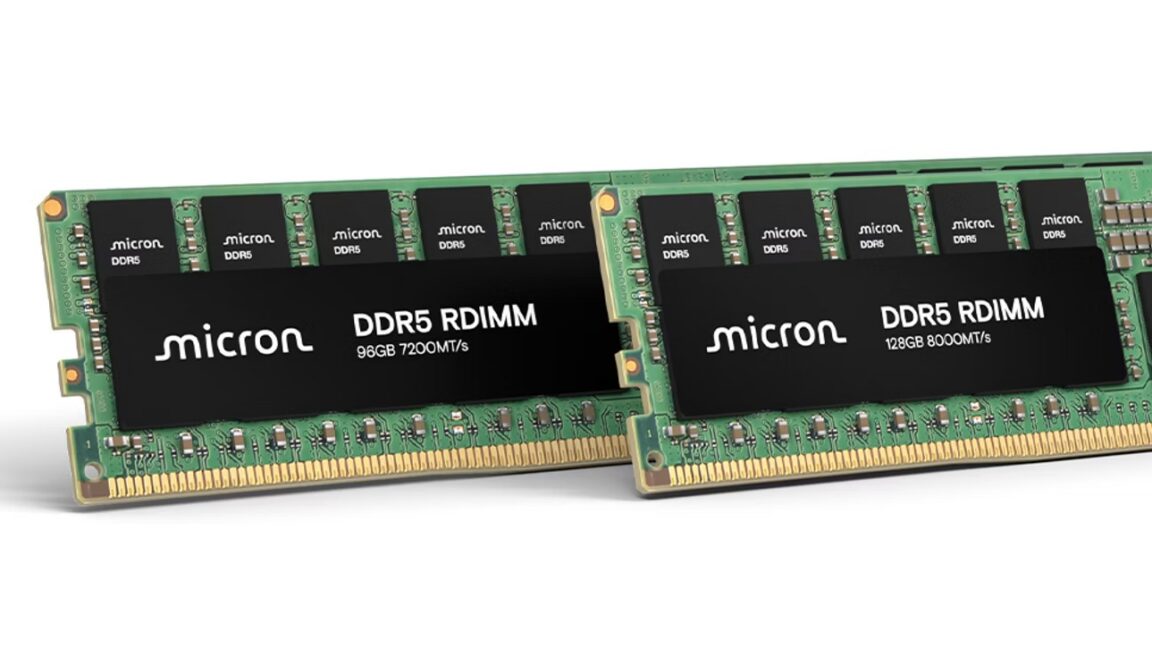
Credit: Micron
It’s not a bad time to upgrade your gaming PC. Graphics card prices in the 2020s have undulated continuously as the industry has dealt with pandemic and AI-related shortages, but it’s actually possible to get respectable mainstream- to high-end GPUs like AMD’s Radeon RX 9060 XT and 9070 series or Nvidia’s RTX 5060, 5070, and 5080 series for at or slightly under their suggested retail prices right now. This was close to impossible through the spring and summer.
But it’s not a good time to build a new PC or swap your older motherboard out for a new one that needs DDR5 RAM. And the culprit is a shortage of RAM and flash memory chips that has suddenly sent SSD and (especially) memory prices into the stratosphere, caused primarily by the ongoing AI boom and exacerbated by panic-fueled buying by end users and device manufacturers.
To illustrate just how high things have jumped in a short amount of time, let’s compare some of the RAM and storage prices listed in our system guide from three months ago to the pricing for the exact same components today. Note that several of these are based on the last available price and are currently sold out; we also haven’t looked into things like microSD or microSD Express cards, which could also be affected.
| Component | Aug. 2025 price | Nov. 2025 price |
|---|---|---|
| Patriot Viper Venom 16GB (2 x 8GB) DDR-6000 | $49 | $110 |
| Western Digital WD Blue SN5000 500GB | $45 | $69 |
| Silicon Power 16GB (2 x 8GB) DDR4-3200 | $34 | $89 |
| Western Digital WD Blue SN5000 1TB | $64 | $111 |
| Team T-Force Vulcan 32GB DDR5-6000 | $82 | $310 |
| Western Digital WD Blue SN5000 2TB | $115 | $154 |
| Western Digital WD Black SN7100 2TB | $130 | $175 |
| Team Delta RGB 64GB (2 x 32GB) DDR5-6400 | $190 | $700 |
In short, there’s no escaping these price increases, which affect SSDs and both DDR4 and DDR5 RAM kits of all capacities (though higher-capacity RAM kits do seem to be hit a little harder). If you’re thinking about an SSD upgrade, those increases haven’t become too ludicrous just yet, but if you were thinking about a RAM upgrade, your best bet is to hold on tight to whatever you already have and hope that nothing breaks any time soon.
Memory and storage shortages can be particularly difficult to get through. As with all chips, it can take years to ramp up capacity and/or build new manufacturing facilities. Not only do we need to meet today’s demand with supply levels that were decided years ago, but manufacturers also must try to decide tomorrow’s supply levels based on today’s demand. This was part of the problem during the pandemic-fueled chip shortages of 2021 and 2022—most companies weren’t prepared for the pandemic-fueled spike in demand for consumer tech, or for the lull in normal buying and upgrade patterns that followed (just look at PC sales, which went way up in 2020 and 2021, then crashed for a while, and then eventually returned to something resembling a normal pattern).
And memory makers in particular may be slow to ramp up manufacturing capacity in response to shortages. If they decide to start manufacturing more chips now, what happens if memory demand drops off a cliff in six months or a year (if, say, an AI bubble deflates or pops altogether)? It means an oversupply of memory chips—consumers benefit from rock-bottom prices for components, but it becomes harder for manufacturers to cover their costs. Memory shortages in late 2016 and 2017, for example, led to oversupply and big price cuts in 2018 and 2019, and some pretty awful earnings reports for manufacturers like Samsung and SK Hynix.
The upshot is: Not only are memory prices getting bad now, but it’s exceptionally difficult to predict when shortage-fueled price hikes might end.
It’s not just PC builders
PC and phone manufacturers—and makers of components that use memory chips, like GPUs—mostly haven’t hiked prices yet. These companies buy components in large quantities, and they typically do so ahead of time, dulling the impact of the increases in the short-term. The kinds of price increases we see, and what costs are passed on to consumers, will vary from company to company.
Bloomberg reports that Lenovo is “stockpiling memory and other critical components” to get it through 2026 without issues and that the company “will aim to avoid passing on rising costs to its customers in the current quarter.” Apple may also be in a good position to weather the shortage; analysts at Morgan Stanley and Bernstein Research believe that Apple has already laid claim to the RAM that it needs and that its healthy profit margins will allow it to absorb the increases better than most.
Framework on the other hand, a smaller company known best for its repairable and upgradeable laptop designs, says “it is likely we will need to increase memory pricing soon” to reflect price increases from its suppliers. The company has also stopped selling standalone RAM kits in its online store in an effort to fight scalpers who are trying to capitalize on the shortages.
Tom’s Hardware reports that AMD has told its partners that it expects to raise GPU prices by about 10 percent starting next year and that Nvidia may have canceled a planned RTX 50-series Super launch entirely because of shortages and price increases (the main draw of this Super refresh, according to the rumor mill, would have a bump from 2GB GDDR7 chips to 3GB chips, boosting memory capacities across the lineup by 50 percent).

-
 C114 Communication Network
C114 Communication Network -
 Communication Home
Communication Home


